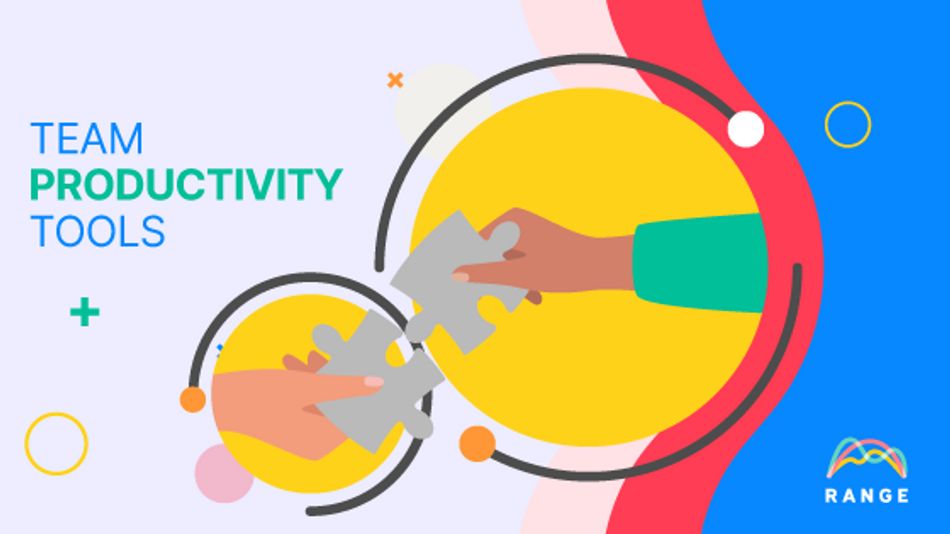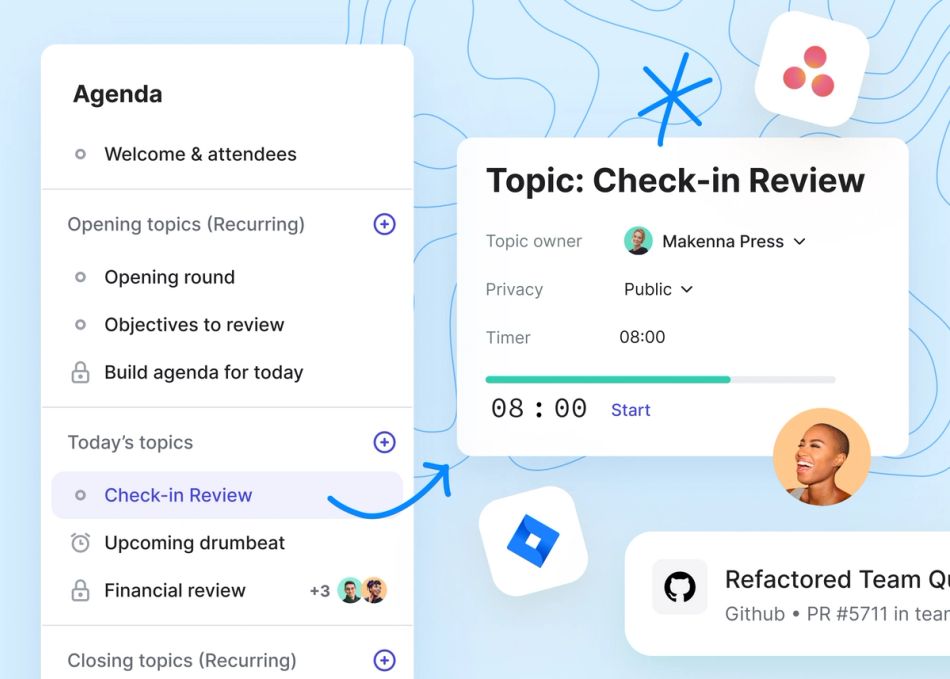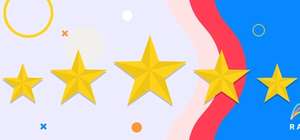
Let's face it; getting teams to work together efficiently and productively isn't easy, even under ideal circumstances. And today, with 59% of Americans working from home most or all of the time, collaboration among team members faces additional challenges. From struggling to communicate across time zones to poor internet connections interrupting live video meetings, remote workers face some serious logistical struggles.
Still, if you're looking to maximize efficiency with your remote (or non-remote) team, the good news is that there are plenty of tools available to help you do just that. From improving communication across time zones to helping team leaders better manage projects, the right productivity tools can make all the difference.
Of course, with so many options out there, how can you choose the team productivity tools that are right for your organization and its unique needs? We've got you covered with these tried-and-true solutions.
What are the best productivity tools? Features, pros, and cons
Now that you have a better idea of some of the key benefits of team collaboration tools, it's time to dive into our list of the best productivity solutions out there. We'll cover not just key features of each platform, but some advantages and potential drawbacks as well. From there, you can make a more confident and informed decision regarding which platforms may be best used for your organization's needs.
1. Range
Use it for: Async team check-ins & meeting notes
Stop unproductive meetings and always know how work is moving forward with Range. Range is a team communication tool for check-ins and meeting management, including agendas. You can reduce meeting load by keeping every team member informed, and easily share your work plans and what you accomplished.
Use async check-ins to connect with your team, share updates via Slack or Microsoft Teams, set custom questions, and add tasks from your project management tools.
Range is the central place for your most important things at work.
Pros
- Set async check-ins to share your work no matter where your team is located
- Build meeting agendas, record actions, and share notes automatically
- Check in on a personal level and stay in-the-know with your colleagues
- Create goals for metrics, objectives, and KPIs
- With hashtags, see all artifacts, documents updates, and day-to-day progress in one central location
- Integrate 75+ productivity tools from across your workflow, including Github, Google Docs, Google calendar, and more
Pricing
- Free: Up to 12 users
- Standard: $8 per user
- Premium: Enhanced security features
2. Asana
If you're looking for a functional and versatile team productivity tool, Asana is worth considering. Specifically, this tool makes it easy to take control over individual tasks by assigning them to team members within project boards or project lists. From there, team leaders and users can easily add attachments, comments, subtasks, and more. Within each project, you can also set specific milestones and deadlines to help keep team members on track and help them visualize the big picture.
Asana offers both free and paid plans, so you can choose the option that's best for you. Overall, this is a great tool if you want to improve productivity and keep everybody on the same page — even when your team members are working from home.
Key features
- Timeline and Gantt chart for easy task management
- Task automation for streamlined work
- Project boards and project lists to keep team members focused
- Reliable and user-friendly task management and project tracking
Pros
- Seamless integration with popular platforms like Jira, Gmail, and more
- Online and mobile (iOS and Android) apps
- Easily customizable and intuitive interface
- Enterprise plan can be tailored to an organization's needs
Cons
- Can’t assign tasks to multiple users
- Many features only available on paid plans
- Free plan only covers up to 15 users
- Managing more complex tasks can be difficult
3. Trello
The Trello platform is another good option if you're looking for a project management app that focuses on enabling team collaboration. This platform is based on the concept of the Kanban board, which essentially breaks up tasks into "to-do," "ongoing," and "completed" categories. This concept has proved to be especially effective among remote teams, as having a visual of tasks (and their status or progress at any given time) can keep team members on track and on the same page.
Like many productivity tools, Trello offers a free version that supports up to 10 Kanban boards per team. However, paid plans with unlimited boards are also available and are priced per-user.
Key features
- Task customization to add due dates, comments, and other details
- Workflow animation bot to automate some repetitive tasks
- Instant messaging for real-time communication among team members
Pros
- Kanban board interface makes visualizing tasks and goals easier for team members
- Many integrations available with apps such as Dropbox, Salesforce, Slack, and more
- Drag-and-drop design is easy and intuitive to use
- Available on Windows, Mac, iOS, Android, and web to suit every team member's needs
Cons
- Can take some time to get accustomed to all of Trello's features
- Free version limits attachments to 10MB per upload
- Can get disorganized with larger teams and projects
4. Slack
If you need communication tools that foster greater productivity within your team, Slack is one option you won't want to overlook. This desktop and mobile app makes it easy for team members to communicate in real time or asynchronously (depending on your needs). Think of it as an instant messaging platform, but with so many features to customize your experience.
There's no free plan available for Slack, but plans are quite affordable, with pricing for the Standard plan starting at less than $7 per user per month.
Key features
- Dedicated private and public channels for more focused conversations
- Search feature to make it easy to find information within each messaging session
- Integration with more than 2,000 other apps, including Office 365
Pros
- Built-in file sharing with large file size allowance
- Ability to tag individuals within group messages
- Ability to schedule messages ahead of time
Cons
- Notifications can be overbearing, especially with multiple conversations going at once
- Can take some time to learn and confidently use all the features
- Video calling feature limited to 15 users at a time (may be an issue for larger projects)
5. ClickUp
On the hunt for a catch-all project management software you can rely on for remote work? ClickUp aims to provide a single place to create and manage tasks, upload and share documents, and communicate directly with team members for optimized workflow. In fact, ClickUp's website even guarantees that their platform can help businesses save one day each week in terms of better time management.
And with a pretty robust free plan available, you can get a feel for how well ClickUp works for your team without a monetary commitment. From there, plans start at around $5 per user per month.
Key features
- Calendar integration and automatic syncing
- Boards and roadmap visualization tools with easy-to-use templates
- Time- and goal-tracking tools
Pros
- Highly customizable to suit the needs of your organization or individual team
- Keeps files, communications, and tasks in a centralized location
- New upgrades and features being added regularly
Cons
- Pages sometimes need to be refreshed multiple times to update
- Ability to customize every detail may be overwhelming or intimidating for some
- Lacks a live chat feature
6. GitHub
If software development is a big part of what your teams do, then GitHub can streamline your operations. GitHub boasts a large community of more than 83 million software developers who contribute to the open-source platform. Offering reliable version control and collaboration tools, GitHub makes it easier for teams to exchange and share code, review projects, and manage coding in real time.
Key features
- Discussions provide a dedicated space for conversation and questions and answers
- Pull requests allow contributors to notify of changes they've made before they're accepted
- Customized notifications allow users to receive updates on activity they've subscribed to
- Copilot feature provides suggestions for functions and whole lines directly inside the code editor
Pros
- Supports markdown files
- Detailed version control keeps a record of which changes were made and by who
- Free to use (with paid plans available for larger teams)
Cons
- Steep learning curve for new developers
- Users report some occasional server downtime
- Size restrictions may be an issue for some larger products
7. Google Workspace
Previously known as G-Suite, Google Workspace offers a wide range of tools designed to help large and small businesses alike better collaborate, communicate, and tackle tasks. In many ways, this platform can be a one-size-fits-all solution to your team's efficiency challenges. With tools ranging from Gmail to Google Docs, Sheets, Slides, and Meet, Google Workspace offers solutions for any organization.
From a collaboration standpoint, users enjoy the ability to share files, edit documents, and track changes directly within the platform. And with two plans to choose from (Google Workspace Basic and Google Workspace Business), there's an option to suit your needs.
Key features
- Web interface and mobile apps available
- User and role management
- Cloud collaboration
- Real-time chat, including voice chat and video conferencing abilities
Pros
- Wide range of interconnected tools at your team's disposal
- Excellent security features
- Integration with other platforms, such as Slack
Cons
- Cloud-based only, which may be a drawback for some organizations
- Free storage maxes out at 15GB
- Initial setup can be time-consuming
8. Notion
When your team works remotely, being able to collaborate, upload documents, and manage projects all in one place can help things run much more smoothly and efficiently. Notion is a platform that provides a single solution for all those things (and more) in a convenient and easy-to-use tool. Likewise, this is a great tool for helping team members visualize their work and track their progress, which can enhance productivity.
The best part is that it's totally free to get started with an individual account. If you decide to add your team, prices range from about $4 per user per month to $8 per user per month depending on the features you need.
Key features
- Ability to create documents and checklists
- Easy note organization for all users
- Task management tools
Pros
- Simple and intuitive interface with a clean user experience
- Available in both desktop and mobile apps
- Customizable views for each user
- Integration with other popular apps, such as Evernote for note-taking
Cons
- Costs can add up for growing businesses and start-ups
- Occasional bugs can hinder usability
- Lacks a live recording feature
9. Jira
Another project management tool to consider for your growing organization is Jira, a web app that allows you to plan and manage tasks and projects across your entire company. Meanwhile, the platform itself can integrate with a number of other apps, plug-ins, and even Google Chrome extensions to help your team get more out of it. From time blocking and tracking to onboarding and reporting, you can do just about anything with Jira. And with four different plans to choose from, you can find one that works for your organization and budget.
Key features
- Development tablets for launching new projects
- Project roadmaps for tracking progress
- Mobile apps for Android and iOS for working on the go
- Permissions and access control for task management and collaboration
Pros
- Kanban boards, scrum boards, and other visualization tools to enhance productivity
- Plenty of configurations and customization options to choose from
- User-friendly layout and interface
Cons
- Some features are restricted to administrators
- Mobile app has some limitations compared to the web app
- Upper tier membership plans can get costly
What makes a productivity tool great?
Now that we’ve analyzed the best collaboration tools, let's review exactly what makes a productivity solution great to begin with. This can help you get a better feel for the features you should look for as you explore your options.
1. Easily integrates with other apps
If your business already relies on other apps and software programs to keep things running smoothly, then finding a project management tool that easily integrates with those apps is a must. This means that you'll be able to link your other apps to your productivity software so that data can be shared between them. In turn, your team members get more out of the platform while spending less time switching between different apps.
Any reputable productivity platform will offer a list of popular apps and programs with which they are compatible. This may not be an exhaustive list, though, so you may want to reach out directly if you don't see a specific app that you use on their list of integrations.
2. Lets your team organize and prioritize tasks according to your needs
Many teams (both remote and in-office) struggle to organize and prioritize the flurry of tasks that need to be tackled on a daily, weekly, or even monthly basis. A great productivity tool makes it easy for team leaders and team members alike to not only create lists of tasks that need to be completed, but to organize and arrange them according to level of priority (and other factors).
For example, some productivity apps allow users to filter and rearrange tasks based on deadlines. Others allow you to color-code tasks to give team members the visuals they need to work accordingly.
3. Automates recurring and repetitive tasks
According to a 2021 global worker survey, the average worker is believed to waste an average of 4 1/2 hours each week on tasks that could be automated. Meanwhile, the same survey finds that 67% of office workers across the globe feel hindered by completing repetitive tasks on the job.
The right productivity software should be able to automate some of those everyday repetitive tasks within your organization, and even between apps that your team uses. This frees up valuable time that your team can use to be truly productive and make the most of each workday.
4. Increases visibility for every task stakeholder
A great productivity app will offer greater insights and visibility into work — not just from a team perspective, but for individual stakeholders as well. With visibility features like time tracking, task management, and reporting, team members can get a better feel for where each project stands (and what their responsibilities are) without the need to schedule a phone call or meeting. This frees up more valuable time while keeping task stakeholders on track, even when they're working remotely and asynchronously.
Boost team productivity with Range
The right productivity software can make all the difference in how your team members work together to get the job done.
Whether you're looking for help with time management, team communication, task management, or anything in between — there's bound to be a productivity tool to help make it happen. Depending on your industry and organizational needs, it's possible that you may even want to incorporate more than one of these solutions.

At Range, we're committed to providing teams with the tools they need to collaborate better and move forward faster. Teams love our check-in feature, which helps to keep team members informed and connected asynchronously.
Learn more about all the features Range has to offer by scheduling a demo from our knowledgeable and friendly team.
You can also sign up to get started for free today!








